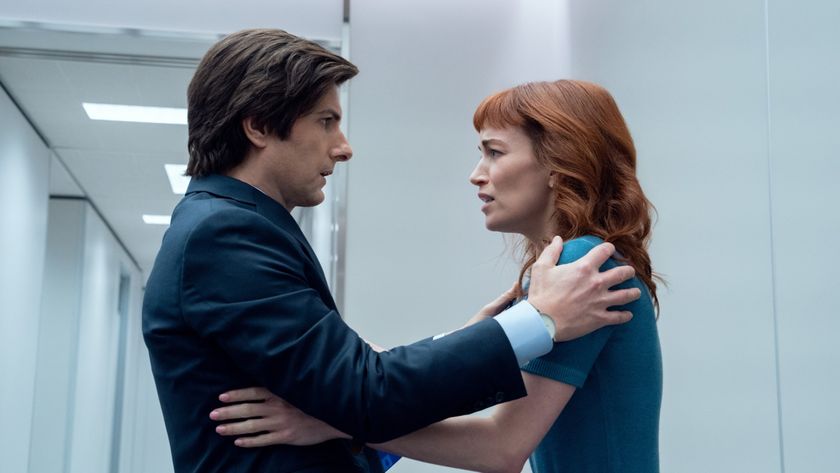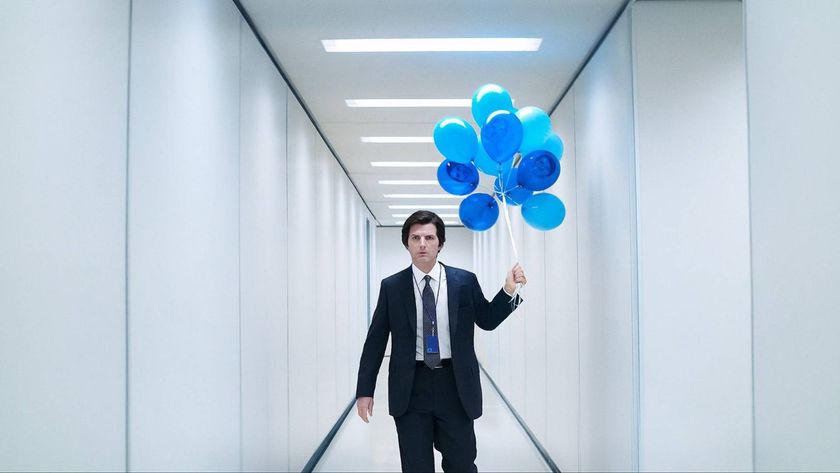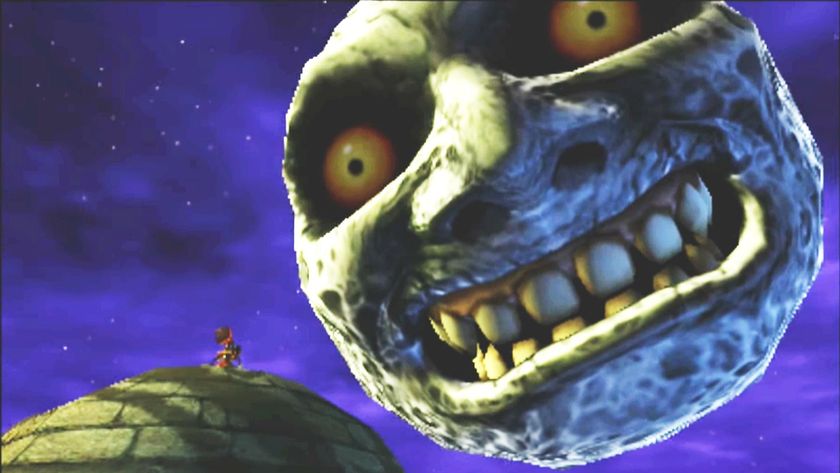Every Star Trek Discovery Easter egg and hidden reference you might have missed
Impress your friends with every Star Trek Discovery Easter egg from season 2 so far
Episode 14
Classified data
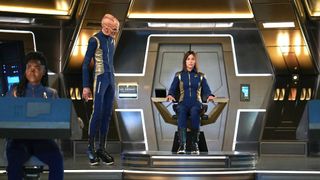
We’ve been wondering all season how the show could venture into the Mirror Universe a decade before it is apparently discovered by Kirk and Co - and now we know the truth.
“All evidence of your recent journey will be classified and destroyed. We cannot risk the knowledge of this alternate universe leaving the confines of Discovery,” says Cornwell, suggesting that revealing this news would be highly dangerous in a time of war. It’s a simple explanation, but it works.
As she rightly points out it would be disastrous for Starfleet morale if it gets out that there’s a universe where everyone who has been killed in the war is potentially still alive and just a Mycelial jump or a transporter malfunction away.
A venerable name
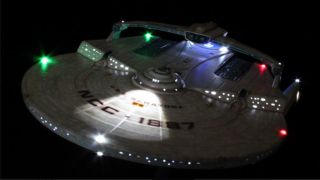
The name USS Saratoga has a long and proud history in Starfleet. The ship we encounter in this episode is now canonically the first known Federation vessel to bear the name, but there are at least three others previously established in Trek lore.
In Star Trek IV: The Voyage Home, set exactly 30 years after Discovery, the USS Saratoga NCC-1887 encounters a mysterious alien probe on a peculiar quest to talk to whales.
The following century, the USS Saratoga NCC-31911 is destroyed at the battle of Wolf 359 by the Borg. It’s on this ship that future Deep Space 9 Captain Benjamin Sisko serves and loses his wife, Jennifer, in the conflict.
Following this, another Saratoga is built and appears in the Deep Space 9 episode Wrongs Darker Than Death or Night.
We don’t get confirmation of the ship’s registry in that episode, but the novel Saratoga (by Michael Jan Friedman) states that it is NCC-31911A. All three are Miranda-class starships, the same as the USS Reliant from The Wrath of Khan.
Sign up to the SFX Newsletter
Get sneak previews, exclusive competitions and details of special events each month!
100 years of hostility
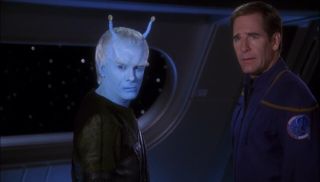
This episode hints at a reference to the oft-derided prequel series, Enterprise, and then makes it explicit.
“This brave team will be the first to visit this inhospitable planet since Captain Archer and the crew of the Enterprise NX-01, nearly 100 years ago,” says Admiral Cornwell, and it is indeed pretty much dead on a century since the events of Broken Bow, Enterprise’s pilot episode, which establishes the first contact between humanity and the Klingons.
Map makers
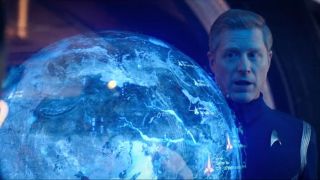
So, it looks like we’re going to Qo’noS next week. Exciting! Keep an eye on the hologramatic globe of the planet on Discovery, and you’ll see several names identifying different parts of the planet.
The Lake of Lusor plays an important part in the myth of Kahless. According to that story (and The Next Generation’s Rightful Heir), the legendary warrior forged the original bat’leth, the Sword of Kahless, from volcanic lava, cooled in the Lake of Lusor. Also named in his honour are the Caves of Kahless, as seen in Voyager’s Day of Honor, where B’Elanna and Tom recreate the caverns on the ship’s holodeck.
You may also spot Kang’s Summit - first referred to in Deep Space 9’s In Purgatory’s Shadow. This is a dangerous mountain where Klingon General Martok is captured by the forces of the marauding Dominion. The mountain is itself another reference - Kang is one of the Empire’s most feared warriors. He tested Kirk’s mettle in Day of the Dove, and is encountered again in Deep Space 9’s Blood Oath and Voyager’s Flashback.
Episode 13
A belated log
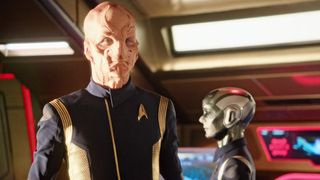
Yep, in last week’s episode, Acting Captain Saru gave Discovery it’s first ever Captain’s Log. This device has been a grand tradition of every iteration of the franchise to date. It's one of the tropes most commonly associated with Star Trek, so it's a little surprising that it’s taken us to nearly the end of the season to get one, but then the Disco’s previous Captain was never one for upholding Starfleet traditions...
Episode 11
That's a novel use for the transporter...
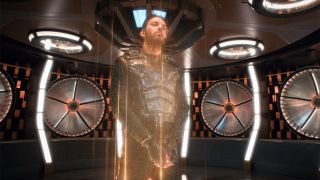
This episode introduces the grim practice of using the transporter to beam criminals or other miscreants unprotected into open space as a form of death penalty. That doesn't happen in the prime universe - at least not legally. It's not the first time the device has been used as a weapon, however. In Enterprise’s Chosen Realm Captain Archer convinces an enemy that the transporter is used by humans for executions, then secretly uses it to escape to another part of the ship. Burnham uses a similar ploy to transport Voq into open space, ready for the Discovery to pick him up and imprison him before he dies.
"Kill them all."
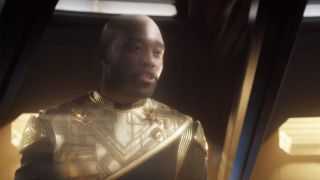
This is an amusingly dark inversion. The Federation's General Order 4 is that “Starfleet expressly forbids the death penalty”. Here in topsy-turvy hyper-violent mirror universe, it’s that General Order 4 states "any exotic species deemed a threat to the Imperial Supremacy will be extinguished without prejudice".
Alien nations
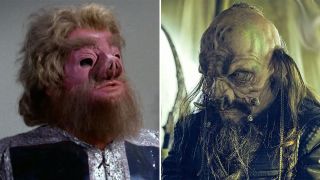
References to the Tellarites and Andorians - both founder species of the Federation - have abounded this season, so it was only a matter of time before they actually showed up. The blue-skinned Andorians look reassuringly familiar to the design established in both the Original Series and Enterprise, with perhaps a little more detail on the skin around the mouth.
The Tellarites, meanwhile, had a more substantial redesign. In their original series debut, Journey to Babel, they were big rubber-faced weirdos with piggy snouts. Enterprise gave them a more realistic look, while Discovery goes a step further, adding tusks and beards that recall Next Gen-era Klingons.
Sarek’s beard!
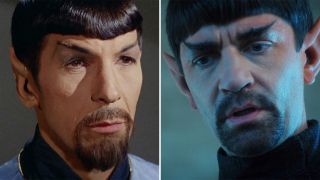
Famously, the original show’s Mirror, Mirror differentiated between the prime and mirror universe Spocks by using a stick on goatee. That’s echoed here in the form of Sarek, now working for the resistance and rocking some similar facial hair. This scene goes a little further than simply echoing a visual, however. It’s also a subtle spin on the scene in Mirror, Mirror where Spock mind melds with Dr McCoy and realises that he is in a different universe.
Episode 10
"This is not our universe..."

The mirror universe is first explored in the classic Original Series instalment, Mirror, Mirror. In that episode, a transporter malfunction opens up a breach between the two realms and the crew meet an evil (and bearded) Spock. It’s a reality where all the good things about Star Trek are reversed. Instead of a peaceable, utopian Federation, humanity is a warrior species, part of the all-conquering, fascist Terran Empire. Instead of working together for the good of the species, starship officers are more likely to stab each other in the back.
Interestingly, that episode is canonically the first contact between the two universes, so how will Discovery justify their encounter here? Assuming that the show isn't just going to conveniently ignore that fact, it suggests that for some as-yet-unknown reason the crew will either be forced to keep schtum about their experiences here, undergo some sort of mass mindwipe or - admittedly very unlikely - they never make it home! I can't see that happening, but I wouldn't mind too much if it meant we got to see more of Captain Killy...
While both the Next Generation and Voyager skipped over the concept, Deep Space Nine returned to the mirror universe several times throughout its run. Over the course of the series various members of the DS9 crew flitted back and forth between realities, finding a radically different DS9 (here known as Terok Nor) and their own sadistic counterparts. It's a particularly painful experience for Captain Sisko, whose long-dead wife Jennifer still lives in the mirror reality.
Enterprise also took a trip to the dark side in its fourth season. The In a Mirror, Darkly two-parter got around that pesky first contact problem by being entirely set in the other universe, with no one from the prime reality crossing over.
Continue to Page 9 for more Star Trek Discovery Easter eggs

Will Salmon is the Comics Editor for GamesRadar/Newsarama. He has been writing about comics, film, TV, and music for more than 15 years, which is quite a long time if you stop and think about it. At Future he has previously launched scary movie magazine Horrorville, relaunched Comic Heroes, and has written for every issue of SFX magazine for over a decade. He sometimes feels very old, like Guy Pearce in Prometheus. His music writing has appeared in The Quietus, MOJO, Electronic Sound, Clash, and loads of other places and he runs the micro-label Modern Aviation, which puts out experimental music on cassette tape.
Most Popular





